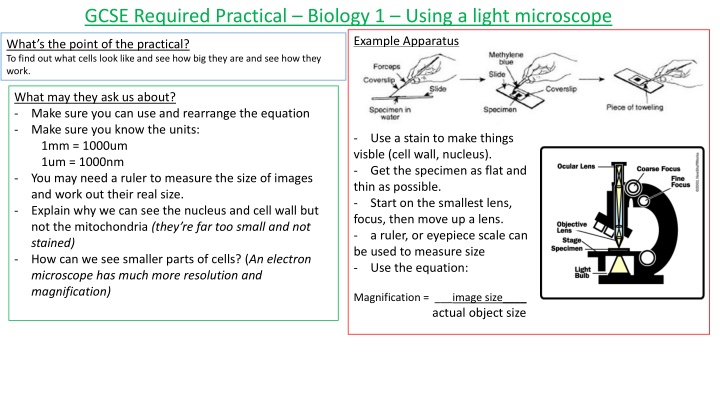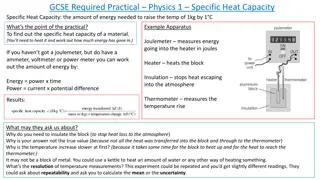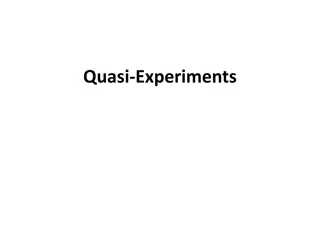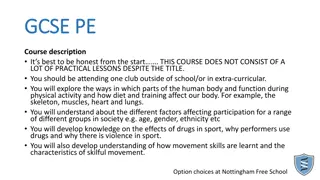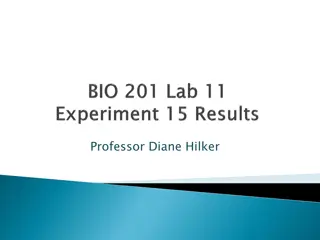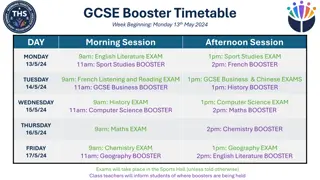GCSE Required Practical Biology Experiments Overview
Explore GCSE Required Practical Biology experiments including using a light microscope, investigating osmosis, conducting food tests, and studying amylase enzyme activity. Understand the objectives, apparatus, results, and potential questions that may be asked in each experiment. Gain insights into cell structures, water movement in plant tissues, food composition tests, and enzyme reactions.
Download Presentation

Please find below an Image/Link to download the presentation.
The content on the website is provided AS IS for your information and personal use only. It may not be sold, licensed, or shared on other websites without obtaining consent from the author.If you encounter any issues during the download, it is possible that the publisher has removed the file from their server.
You are allowed to download the files provided on this website for personal or commercial use, subject to the condition that they are used lawfully. All files are the property of their respective owners.
The content on the website is provided AS IS for your information and personal use only. It may not be sold, licensed, or shared on other websites without obtaining consent from the author.
E N D
Presentation Transcript
GCSE Required Practical Biology 1 Using a light microscope Example Apparatus What s the point of the practical? To find out what cells look like and see how big they are and see how they work. What may they ask us about? - Make sure you can use and rearrange the equation - Make sure you know the units: 1mm = 1000um 1um = 1000nm - You may need a ruler to measure the size of images and work out their real size. - Explain why we can see the nucleus and cell wall but not the mitochondria (they re far too small and not stained) - How can we see smaller parts of cells? (An electron microscope has much more resolution and magnification) - visble (cell wall, nucleus). - Get the specimen as flat and thin as possible. - Start on the smallest lens, focus, then move up a lens. - a ruler, or eyepiece scale can be used to measure size - Use the equation: Use a stain to make things Magnification = ___image size____ actual object size
GCSE Required Practical Biology 1 Investigating Osmosis Osmosis: the movement of water from an area with high concentration OF WATER, to an area with lower concentration OF WATER. Solute: something that dissolves in water Example Apparatus What s the point of the practical? To find out what happens to cells when you put them in different concentrations of sugar or salt solutions. (to see how the water moves in or out of the plant tissue) Results - High concentration of sugar in solution = water moves out of potato cells into the solution. Potato gets smaller. -Low concentration of sugar in solution = water moves into the potato cells from the solution. Potato gets bigger. - - Different concentrations of sugar (or salt) Measure the length (or mass) of the potato cylinders before and after. What may they ask us about? - Control variables - Accuracy of measurements why should you remove excess water with paper towel before weighing - Use a graph of results to find the concentration inside the potato cells - Why can the water, but not the sugar/salt move through the membrane? -If no water goes in or out of the potato overall and it doesn t change mass, then the solution is exactly the same concentration as inside the potato
GCSE Required Practical Biology 1 Food Tests What s the point of the practical? To find out if sugars, starch and/or proteins are in certain foods. What may they ask us about? - Qualitative test (tell you just yes/no) vs Quantitative (tells you how much) tests. - Sources of error how could you make mistakes? - Why is it hard to judge colour change accurately? - Resolution of measurements, repeatability, reproducibility etc. Example Apparatus and results
GCSE Required Practical Biology 1 Investigating amylase enzyme Enzyme: a biological catalyst. Speeds up reactions in the body by lowering the activation energy. pH: how acidic or alkali a substance is (1 = strong acid, 7=neutral, 14 = strong alkali) Amylase: an enzyme that breaks down starch into sugar Example Apparatus What s the point of the practical? To find out what happens to the rate of enzyme activity when the pH changes. Results - At low pH and high pH, the iodine keeps turning black because the enzyme has been denatured. - After just a few minutes at pH 7-9, the iodine stays brown the starch has all broken down into sugar. - - Starch reacts with amylase in a water bath Take samples from the mixture every 30 seconds and add it to iodine Iodine goes black = starch present Iodine stays brown = no starch present (it s reacted) - - What may they ask us about? - Why do you need a water bath? (To maintain the correct temperature, because temperature affects reaction rate) - If you test at pH 3,4,5,6,7,8,9 and 10, Why don t we know the exact optimum pH? (because although two answers may both show quick reactions (e.g. pH7 and pH8), the actual optimum could be between those number (e.g. pH 7.6) so you need to test different pH s to find out the exact optimum. - Sources of error and weaknesses e.g. in measuring, starting and stopping timers etc
GCSE Required Practical Biology 1 Light and Photosynthesis Example Apparatus Photosynthesis: when plants use carbon dioxide and water to make glucose (and oxygen). Happens in the chloroplast and needs light to happen. What s the point of the practical? To find out what happens to the rate of photosynthesis when we change the light intensity Results - The closer the lamp, the quicker the bubbles are produced (so higher rate of photosynthesis) What may they ask us about? - Why results may be inaccurate (difficult to count very small bubbles, each bubble counts as 1 no matter how big it is) - Why should you leave the plant for a few minutes before starting to count bubbles (as it takes time for the plant to adjust to the light/temperature and for photosynthesis to reach the correct rate). - Heat from the lamp is a source of error, how could you avoid this? (Place a glass screen in front of the beaker so that light gets through but heat doesn t) - What are the other limiting factors apart from light? Why will rate of photosynthesis level off, even with maximum light? (The plant also needs enough temperature and CO2)
